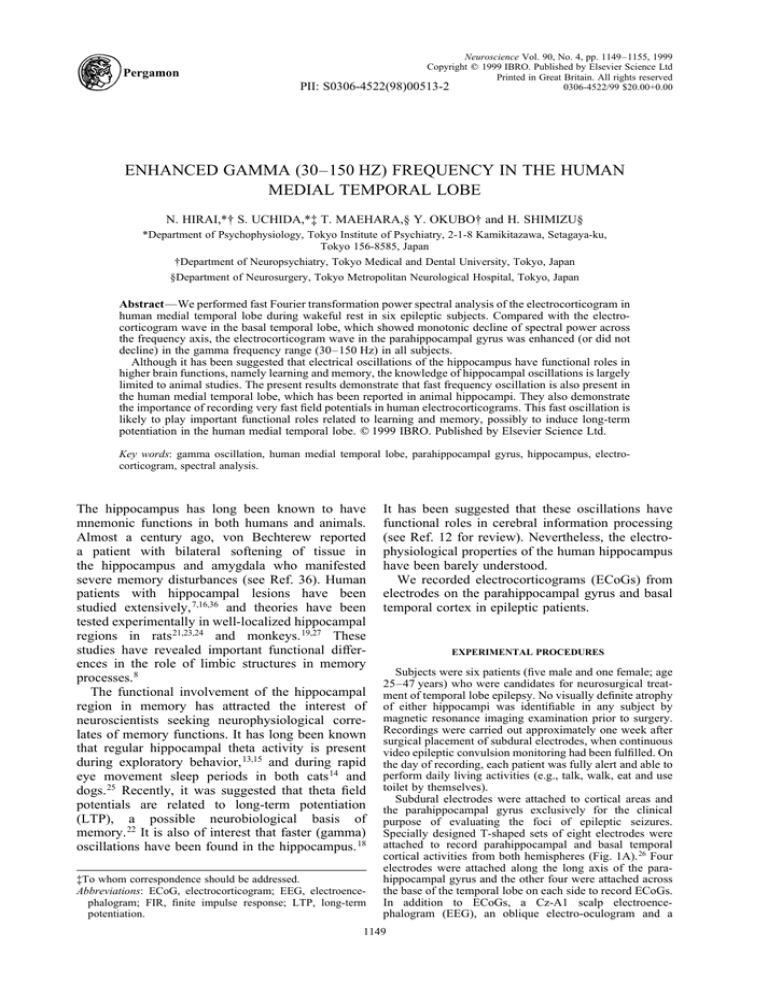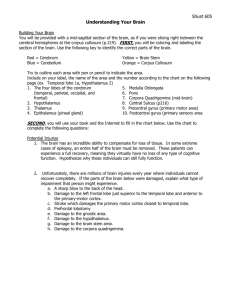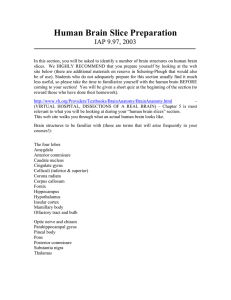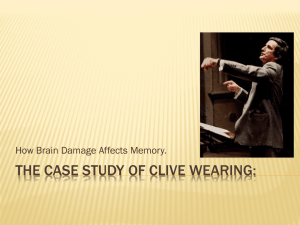
Pergamon
PII:
Neuroscience Vol. 90, No. 4, pp. 1149–1155, 1999
Copyright 䉷 1999 IBRO. Published by Elsevier Science Ltd
Printed in Great Britain. All rights reserved
0306-4522/99 $20.00+0.00
S0306-4522(98)00513-2
ENHANCED GAMMA (30–150 HZ) FREQUENCY IN THE HUMAN
MEDIAL TEMPORAL LOBE
N. HIRAI,*† S. UCHIDA,*‡ T. MAEHARA,§ Y. OKUBO† and H. SHIMIZU§
*Department of Psychophysiology, Tokyo Institute of Psychiatry, 2-1-8 Kamikitazawa, Setagaya-ku,
Tokyo 156-8585, Japan
†Department of Neuropsychiatry, Tokyo Medical and Dental University, Tokyo, Japan
§Department of Neurosurgery, Tokyo Metropolitan Neurological Hospital, Tokyo, Japan
Abstract—We performed fast Fourier transformation power spectral analysis of the electrocorticogram in
human medial temporal lobe during wakeful rest in six epileptic subjects. Compared with the electrocorticogram wave in the basal temporal lobe, which showed monotonic decline of spectral power across
the frequency axis, the electrocorticogram wave in the parahippocampal gyrus was enhanced (or did not
decline) in the gamma frequency range (30–150 Hz) in all subjects.
Although it has been suggested that electrical oscillations of the hippocampus have functional roles in
higher brain functions, namely learning and memory, the knowledge of hippocampal oscillations is largely
limited to animal studies. The present results demonstrate that fast frequency oscillation is also present in
the human medial temporal lobe, which has been reported in animal hippocampi. They also demonstrate
the importance of recording very fast field potentials in human electrocorticograms. This fast oscillation is
likely to play important functional roles related to learning and memory, possibly to induce long-term
potentiation in the human medial temporal lobe. 䉷 1999 IBRO. Published by Elsevier Science Ltd.
Key words: gamma oscillation, human medial temporal lobe, parahippocampal gyrus, hippocampus, electrocorticogram, spectral analysis.
The hippocampus has long been known to have
mnemonic functions in both humans and animals.
Almost a century ago, von Bechterew reported
a patient with bilateral softening of tissue in
the hippocampus and amygdala who manifested
severe memory disturbances (see Ref. 36). Human
patients with hippocampal lesions have been
studied extensively, 7,16,36 and theories have been
tested experimentally in well-localized hippocampal
regions in rats 21,23,24 and monkeys. 19,27 These
studies have revealed important functional differences in the role of limbic structures in memory
processes. 8
The functional involvement of the hippocampal
region in memory has attracted the interest of
neuroscientists seeking neurophysiological correlates of memory functions. It has long been known
that regular hippocampal theta activity is present
during exploratory behavior, 13,15 and during rapid
eye movement sleep periods in both cats 14 and
dogs. 25 Recently, it was suggested that theta field
potentials are related to long-term potentiation
(LTP), a possible neurobiological basis of
memory. 22 It is also of interest that faster (gamma)
oscillations have been found in the hippocampus. 18
‡To whom correspondence should be addressed.
Abbreviations: ECoG, electrocorticogram; EEG, electroencephalogram; FIR, finite impulse response; LTP, long-term
potentiation.
It has been suggested that these oscillations have
functional roles in cerebral information processing
(see Ref. 12 for review). Nevertheless, the electrophysiological properties of the human hippocampus
have been barely understood.
We recorded electrocorticograms (ECoGs) from
electrodes on the parahippocampal gyrus and basal
temporal cortex in epileptic patients.
EXPERIMENTAL PROCEDURES
Subjects were six patients (five male and one female; age
25–47 years) who were candidates for neurosurgical treatment of temporal lobe epilepsy. No visually definite atrophy
of either hippocampi was identifiable in any subject by
magnetic resonance imaging examination prior to surgery.
Recordings were carried out approximately one week after
surgical placement of subdural electrodes, when continuous
video epileptic convulsion monitoring had been fulfilled. On
the day of recording, each patient was fully alert and able to
perform daily living activities (e.g., talk, walk, eat and use
toilet by themselves).
Subdural electrodes were attached to cortical areas and
the parahippocampal gyrus exclusively for the clinical
purpose of evaluating the foci of epileptic seizures.
Specially designed T-shaped sets of eight electrodes were
attached to record parahippocampal and basal temporal
cortical activities from both hemispheres (Fig. 1A). 26 Four
electrodes were attached along the long axis of the parahippocampal gyrus and the other four were attached across
the base of the temporal lobe on each side to record ECoGs.
In addition to ECoGs, a Cz-A1 scalp electroencephalogram (EEG), an oblique electro-oculogram and a
1149
1150
N. Hirai et al.
loaded onto a computer hard disk, and 750-Hz data were
obtained using the same methods applied to analog data.
We analysed signals from three parahippocampal
montages and three basal temporal montages (H1, H2, H3
and T1, T2, T3 in Fig. 1B) on both sides during resting
wakefulness with eyes closed. Fast Fourier transformation
was performed on 50 1024-point (1.37 s) epochs. These
68.27 s of artifact and epileptic discharge-free ECoG signals
were visually selected for statistical analyses. Every two fast
Fourier transformation frequency bins were summed to
obtain frequency bins 1.46 Hz wide. Power spectra from
each pairing of the six derivations were compared for each
1.46-Hz bin for each subject, using the Mann–Whitney Utest.
This protocol was approved by the Tokyo Institute of
Psychiatry ethical committee. A written informed consent
was obtained from each patient prior to the recording.
RESULTS
Fig. 1. Electrode positions (A) and ECoG derivations (B). Note
that electrode positions approximate but did not precisely locate
each described gyrus.
chin electromyogram were recorded to monitor the state of
consciousness.
All signals were recorded on either a TEAC XR-9000 28
channel FM analog tape recorder, TEAC SR-8000 or Sony
SIR-1000 32 channel digital recorders. Data recorded on
analog tape were digitized at or above 1500 Hz and the
sampling rate was further reduced with a finite impulse
response (FIR) high cut filter (cut-off frequency 300–
350 Hz) to obtain 750-Hz digital data. Data on digital tape
were similarly sampled at 3000 Hz or above, then down-
A representative subject’s raw parahippocampal
(left H3) and basal temporal (left T3) signals and
30–150 Hz FIR band-pass filtered waves are
shown in Fig. 2. The parahippocampal signal exhibits continuous fast activities, as compared with the
signal from the basal temporal ECoG.
Figure 3C presents spectra from the posterior part
of the left parahippocampal gyrus (H3) and left
lateral basal temporal lobe (T3) of the same subject
as in Fig. 2. T3 of the ipsilateral basal temporal lobe
was chosen for comparison since it was most distant
from the hippocampus and considered to be less
influenced by hippocampal field potentials. The H3
signal showed significantly higher activity, from 28
to nearly 250 Hz, with a 30–150 Hz band showing
characteristic enhancement (Fig. 3C). In this patient,
Fig. 2. The upper two tracings are raw ECoG waves recorded from H3 and T3 derivations. The lower two tracings
are their 30–150 Hz FIR filtered waveforms. Gamma oscillations are apparent in the parahippocampal signals.
Human gamma oscillation in the medial temporal lobe
Fig. 3. Power spectrum of one case of gamma enhancement in the posterior parahippocampal gyrus. Thick lines
are power spectra from parahippocampal gyrus; the thin line is from the ipsilateral basal temporal derivation (T3).
The shaded area indicates significant differences (Mann–Whitney U-test, P ⬍ 0.05) between parahippocampal
gyrus and basal temporal power. Although significant differences were also present in wider bands, 30–150 Hz
enhancement was significant in the H2 and H3 derivations.
1151
1152
N. Hirai et al.
Fig. 4. Power spectrum of one case of gamma enhancement in the anterior part. Thick lines indicate parahippocampal and thin lines indicate basal temporal spectra, as in Fig. 3. Note that 30–150 Hz is enhanced in the anterior
part (H1). The shaded area indicates significant differences (Mann–Whitney U-test, P ⬍ 0.05) between parahippocampal and basal temporal power. There were significant differences between H3 and T3 in almost all
frequency bands. However, the shapes of the spectral curves were similar and neither showed a specific enhancement in the gamma band.
Human gamma oscillation in the medial temporal lobe
the middle ECoG (H2) showed a spectrum similar
(Fig. 3B) to the posterior part (H3). However, the
anterior ECoG (H1; Fig. 3A) showed much smaller
gamma enhancement. This distribution was not
consistent across subjects. Figure 4 illustrates a
case with greater power enhancement of 30–
150 Hz power in the anterior ECoG from the left
parahippocampal gyrus (Fig. 4A). This enhancement is barely present in the middle ECoG (Fig.
4B) and is absent in the posterior ECoG (Fig. 4C).
In this subject, all frequency bands of the posterior
part showed levels significantly lower than those of
the basal temporal ECoG. These differences may
reflect general levels of these two signals.
Of the six subjects, two showed enhanced gamma
frequency power in both left and right posterior
parahippocampal ECoG leads, and two showed
posterior enhancement on one side but anterior
enhancement on the other. The other two could not
be identified because some electrode conditions
were not good enough for satisfactory signal recording. There was no relationship between epileptogenic lateralization and anterior versus posterior
gamma enhancement.
DISCUSSION
In ECoG recordings from the human parahippocampal gyrus, spectral power in the 30–150 Hz band
is significantly enhanced relative to the power in the
basal temporal cortex of awake subjects. To the best
of our knowledge, this is the first report of highfrequency ECoG enhancement in the human medial
temporal lobe. It was difficult to precisely identify
the enhanced frequency in the ECoG from the parahippocampal gyrus compared with the lateral basal
temporal ECoG, because of cross-montage and
inter-subject variations in general signal levels.
However, the shapes of the spectral curve allowed
us to determine that the ECoG power in 30–150 Hz
is enhanced in signals from the parahippocampal
gyrus compared with those from the lateral basal
temporal lobe. Since this band coincides with
gamma frequencies, 3,4,35 we refer to this band as
gamma.
In the past, we have studied human EEG oscillations during sleep. 32–34 We focused on EEG oscillations (over a wider time-scale), since we believe
they are correlates of certain brain functions by the
following rationale. 31 It is known that some neurons
show rhythmic firing. 28 However, even when a
single neuron shows rhythmic firing, oscillatory
field potentials (EEG) will not be observed without
synchronous rhythmic activity of a substantial population of neurons. Therefore, observed EEG oscillations reflect mass neuronal activity in the brain. It is
quite likely that such mass activity is importantly
related to brain functions. Thus, we believe the
local gamma frequency represents function(s) in
the human medial temporal lobe.
1153
Buzsaki et al. 6 reported that, in rats, hippocampal
fast rhythms of 25–100 Hz increased with behavioral activation. Similar frequencies are also
enhanced in rats after locally induced afterdischarge in the hippocampus. 18 The spectral pattern
of the present spontaneous activity from human
parahippocampal gyrus closely resembles the
pattern of enhancement by after-discharge in the
rat hippocampus. Although the frequency is higher
in humans, this similarity may still indicate that
these frequencies reflect similar functional roles,
although these roles remain unknown. This similarity also suggests that the signals recorded from the
parahippocampal gyrus strongly reflect hippocampal
activity.
Bragin et al. 3 reported that gamma (40–100 Hz)
field potentials are present in the hippocampus of the
behaving rat. They suggested that gamma oscillations are generated by an interaction between
intrinsic oscillatory properties of interneurons and
the network properties of the dentate gyrus. The
40–100 Hz frequency they reported largely overlaps
that identified in the present report. Although we
must be cautious in our interpretations because of
differences in our methods (we recorded field potentials and they used microelectrodes), comparisons of
these data could prove useful.
In some cases, frequencies above 150 Hz were
also relatively enhanced in the parahippocampal
ECoG compared to the basal temporal cortex. This
could be caused by average differences in signal
levels between the H3 and T3 derivations. However,
it is also possible that activity in the parahippocampal gyrus per se is enhanced up to 300 Hz.
Enhanced spectral power above 150 Hz might correspond to the 200-Hz high-frequency network oscillation found in the CA1 region of rats. 5 In any case,
the existence of such high-frequency oscillation
suggests that it plays a role in inducing LTP 2 in
the human medial temporal lobe.
The current finding that gamma frequency is
enhanced in the signals from the human parahippocampal gyrus has basic and clinical implications.
One of the most basic questions is why this region
has a power spectrum which differs significantly
from the basal temporal lobe. Since the parahippocampal and hippocampal region has anatomically
different structures from the neocortex, the difference in spectral power could relate to these anatomical differences. It would be of interest to
determine whether this is a general difference
between three-layer and five-layer cortical structures, and whether it is regionally specific. It is
possible that other regions of the cerebral cortex
have these oscillations. 1 Recently, it was reported
that EEG 30–70 Hz oscillatory activity is induced
by a visual search task in humans. 30 We are currently
accumulating ECoG data during task performance
and hope to provide data relating human gamma
oscillations to task performance. Although we
1154
N. Hirai et al.
described 30–150 Hz as a single frequency band
in this paper, task studies may reveal that this
can be divided into discrete functional frequency
bands.
There were differences in the level of gamma
frequency enhancement across the parahippocampal
gyrus and among individuals. Two cases showed
higher gamma in the posterior part of the parahippocampal gyrus; two cases showed higher gamma in
the posterior and the anterior part of the other.
Enhancement locations were not identified in the
remaining two subjects because of an insufficient
number of readable (artifact-free) electrode placements. We can think of several possible explanations
for these differences. One is that, because we
recorded the difference in signals between two electrodes located on the parahippocampal gyrus,
synchronized oscillatory signals could be weak.
This can be resolved by recording signals using a
common extra-hippocampal reference. We are
currently accumulating such recordings. The second
possibility is that epileptic focus in the hippocampus
has not functioned normally. Such regions may not
generate much gamma activity. If regional differences in gamma activity are caused by epileptic
foci, gamma activity levels might predict residual
hippocampal functioning. Such information could
be valuable for anticipating postoperative deficits
in brain function, allowing clinicians to better
explain risks to the patient and to plan treatment
procedures. In functional magnetic resonance
imaging studies, 9,10,29 it was reported that the
posterior medial temporal lobe was activated during
memory performance. In our present results, six
of eight medial temporal lobes (both sides
from four subjects) showed posterior enhancement.
Taken together, it may be suggested that anterior
enhancement occurred to substitute posterior function,
which had been impaired by epileptic pathology.
The extent of coherence of activity in the hippocampal region and other cortical regions would be of
further interest. If the present gamma oscillation has
roles in both LTP induction and cortical information
binding, 4,11 it would be of great interest. Since the
brain works as a system, 1,17 such measures could
lead to an understanding of the role of the hippocampus in overall brain function. Such data could
ultimately help us understand pathological (e.g.,
schizophrenia 20) as well as physiological brain
function.
CONCLUSIONS
In ECoG recordings from the human parahippocampal gyrus, spectral power in the 30–150 Hz band
was significantly enhanced relative to the power in
the basal temporal cortex in awake subjects. These
results demonstrate that fast frequency oscillation is
also present in the human medial temporal lobe,
which has been reported in animal hippocampi.
They also demonstrate the importance of recording
very fast field potentials in human ECoGs. This fast
oscillation is likely to play important functional
roles related to learning and memory, possibly to
induce LTP in the human medial temporal lobe.
Acknowledgements—This study was supported by the
Research Fund from Tokyo Ikashika Daigaku Seishinkai
no Kai (N.H.), Special Coordination Funds for Promoting
Science and Technology from the Science and Technology
Agency (S.U.), and Grants-in-Aid for Fundamental
Research (C) from the Ministry of Education, Science and
Culture (S.U.). We appreciate statistical consultation with
Drs M. Ishiguro, Y. Takizawa, J. C. Jimenez and T. Ozaki of
the Institute of Statistical Mathematics, Tokyo.
REFERENCES
1. Basar E. and Demiralp T. (1995) Fast rhythms in the hippocampus are a part of the diffuse gamma response system.
Hippocampus 5, 240–241.
2. Bliss T. V. P. and Lomo T. (1973) Long-lasting potentiation of synaptic transmission in the dentate area of the anaesthetized
rabbit following stimulation of the perforant path. J. Physiol. 232, 331–356.
3. Bragin A., Jando G., Nadasdy Z., Hetke J., Wise K. and Buzsaki G. (1995) Gamma (40–100 Hz) oscillation in the hippocampus of the behaving rat. J. Neurosci. 15, 47–60.
4. Bressler S. L. (1990) The gamma wave: a cortical information carrier? Trends Neurosci. 13, 161–162.
5. Buzsaki G., Hirvath Z., Urisote R., Hetke J. and Wise K. (1992) High-frequency network oscillation in the hippocampus.
Science 256, 1025–1027.
6. Buzsaki G., Leung L.-W. S. and Vanderwolf C. H. (1983) Cellular bases of hippocampal EEG in the behaving rat. Brain Res.
Rev. 6, 139–171.
7. Corkin S. (1984) Lasting consequences of bilateral medial temporal lobectomy: clinical course and experimental findings in
H.M. Semin. Neurol. 4, 249–259.
8. Eichenbaum H. (1997) How does the brain organize memories? Science 227, 330–332.
9. Fernandez G., Weyerts H., Schrader-Boelsche M., Tendolkar I., Smid H. G. O. M., Tempelmann C., Hinrichs H., Scheich H.,
Elger C. E., Mangun G. R. and Heinze H.-J. (1998) Successful verbal encoding into episodic memory engages the posterior
hippocampus: a parametrically analyzed functional magnetic resonance imaging study. J. Neurosci. 18, 1841–1847.
10. Gabrieli J. D., Brewer J. B., Desmond J. E. and Glover G. H. (1997) Separete neural bases of two fundamental memory
processes in the human medial temporal lobe. Science 276, 264–266.
11. Gray C. M., Konig P., Engel A. K. and Singer W. (1989) Oscillatory response in cat visual cortex exhibit inter-columnar
synchronization which reflects global stimulus properties. Nature 338, 334–337.
12. Gray C. M. (1994) Synchronous oscillations in neuronal systems: mechanisms and functions. J. comput. Neurosci. 1, 11–38.
13. Green J. D. and Arduini A. (1954) Hippocampal electrical activity in arousal. J. Neurophysiol. 17, 533–557.
Human gamma oscillation in the medial temporal lobe
1155
14. Jouvet M., Michel F. and Courjon J. (1959) Sur un stade dactivite electrique cerebrale rapide au cours du sommeil physiologique. C. r. Séanc. Soc. Biol. 153, 1024–1028.
15. Jung R. and Kornmuller A. (1938) Ein methodik der abteilung lokalsierter potential schwankingen aus subcorticalen hirnyebieten. Arch. Psychiat. Neuroenkr. 109, 1–30.
16. Knight R. T. (1996) Contribution of human hippocampal region to novelty detection. Nature 383, 256–259.
17. Koch C. and Davis J. L. (eds) (1994) Large-scale Neuronal Theories of the Brain. MIT, Cambridge, MA.
18. Leung L. S. (1992) Fast (beta) rhythms in the hippocampus: a review. Hippocampus 2, 93–98.
19. Mishkin M. (1978) Memory in monkeys severely impared by combined but not by separate removal of amygdala and
hippocampus. Nature 273, 297–298.
20. Moroji T. and Yamamoto K. (eds) (1994) The Biology of Schizophrenia. Elsevier Science, Amsterdam.
21. Morris R. G. M., Garrud P., Rawlins J. N. and O’Keefe J. (1982) Place navigation impared in rats with hippocampal lesions.
Nature 297, 681–683.
22. O’Keefe J. (1993) Hippocampus, theta, and spatial memory. Curr. Opin. Neurobiol. 3, 917–924.
23. Olton D. S., Becker J. T. and Handelmann G. E. (1979) Hippocampus, space and memory. Behav. Brain Sci. 2, 313–365.
24. Olton D. S., Walker J. A. and Gage F. (1978) Hippocampal connections and spatial discrimination. Brain Res. 139, 295–308.
25. Shimazono Y., Horie T., Yanagisawa N., Hori N., Chikazawa S. and Shozuka K. (1960) The correlation of the rhythmic waves
of the hippocampus with the behaviors of dogs. Neurologia 2, 82–88.
26. Shimizu H., Suzuki I., Ohta Y. and Ishijima B. (1992) Mesial temporal subdural electrode as a substitute for depth electrode.
Surg. Neurol. 38, 186–191.
27. Squire L. R. and Zola-Morgan S. (1988) Memory: brain system and behavior. Trends Neurosci. 11, 1988.
28. Steriade M., Jones E. G. and Llinas R. R. (1990) Thalamic Oscillations and Signaling. John Wiley, New York.
29. Stern C. E., Corkin S., Gonzalez G., Guimaraes A. R., Baker J. R., Jennings P. J., Carr C. A., Sugiura R. M., Vedantham V. and
Rosen B. R. (1996) The hippocampal formation participates in novel picture encoding: evidence from functional magnetic
resonance imaging. Proc. natn. Acad. Sci. U.S.A. 93, 8660–8665.
30. Tallon-Baudry C., Bertrand O., Delpeuch C. and Pernier J. (1997) Oscillatory gamma-band (30–70 Hz) activity induced by a
visual search task in humans. J. Neurosci. 17, 722–734.
31. Uchida S. and Hirai N. (1998) Human sleep EEG oscillations and their neurophysiological significance. In Brain Topography
Today (eds Koga Y., Nagata K. and Hirata K.), pp. 291–296. Elsevier Science, Amsterdam.
32. Uchida S., Maloney T. and Feinberg I. (1992) Beta (20–28 Hz) and delta (0.3–3 Hz) EEGs oscillate reciprocally across NREM
and REM sleep. Sleep 15, 352–358.
33. Uchida S., Maloney T. and Feinberg I. (1994) Sigma (12–16 Hz) and beta (20–28 Hz) EEGs discriminate NREM and REM
sleep. Brain Res. 659, 243–248.
34. Uchida S., Maloney T., March J. D., Azari R. and Feinberg I. (1991) Sigma (12–15 Hz) and delta (0.3–3 Hz) EEGs oscillate
reciprocally within NREM sleep. Brain Res. Bull. 27, 93–96.
35. Wang X.-J. and Buzsaki G. (1996) Gamma oscillation by synaptic inhibition in a hippocampal interneuronal network model. J.
Neurosci. 16, 6402–6413.
36. Zola-Morgan S., Squire L. R. and Amaral D. G. (1986) Human amnesia and the medial temporal region: enduring memory
impairment following a bilateral lesion limited to field CA1 of the hippocampus. J. Neurosci. 6, 2950–2967.
(Accepted 24 June 1998)





